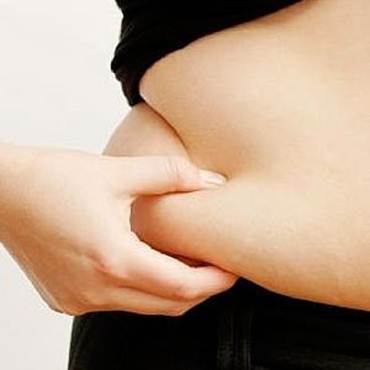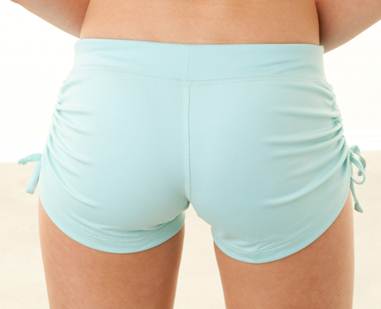Trouble zone: “I carry fat around my stomach”
Diagnosis:
Too much of the stress hormone, cortisol
“If you have excessive fat around your
belly, this suggests you have high levels of the stress hormone, cortisol,”
explains Rein. “Stress raises your blood pressure, while also increasing the
flow of glucose into the blood stream. High cortisol levels caused by lack of
sleep or work-related stress raise your insulin levels, and result in excess
sugar being stored as fat”
How
can I fix it?
Change your diet: The main culprit is
sugar, in the form of alcohol and refined white high-GI grains (white baked
products, pasta and flour), which rapidly raise blood glucose levels, believes
Tomlinson. “Elavated levels of glucose in the blood, directly after eating high
GI foods, triggers the release of insulin, which sweeps the excess glucose out
of the bloodstream and stores it as fat. The best way to balance your blood
glucose levels is to eat foods with a low glycaemic index (GI) that take time
for the body to digest and therefore slow down the amount of glucose entering
your bloodstream. You should also follow a Mediterranean diet, packed with
vegetables and protein, which helps balance blood sugar levels. Half the battle
of stomach fat spot reduction is won by keeping your blood sugar levels
stable,” Tomlinson says.
Rethink
your exercise
“Your cortisol levels are highest at 8am,
so work out in the morning while they are naturally elevated,” suggests Rein.
“You should also keep cardio sessions under 40 minutes, to prevent putting your
body under further stress. Try short and sharp interval sessions, to help tap
into those fat stores while preserving lean muscle tissue. Aim for 10 sets of
30-second sprints followed by 90 seconds’ reat”
What
supplements do I need?
Drink plenty of water with a fibre, such as
Solgar’s Psyllium Husk Fibre, $20 (solgar.com/uk to increase insulin
sensitivity and lower blood sugar, as well as liquorice root. Try good N
Natural Liquorice Root, $12 (hollandandbarrett.com) and Holy Basil, $23 from
Pukka Herbs (pukkaherbs,com) to lower stress levels. Vitamin D3, try Holland
& Barrett $12 for 100 caplets (hollanandbarrett.com), also helps lower
blood sugar.
Don’t forget your weekly rest day!
Rest is important for reducing fat around
your stomach. The stress hormone cortisol, responsible for fat storage around
your middle, falls the more you rest and sleep, so rotate your workouts and,
once a month, add in a fun or soothing workout, such as yoga.

“Work out in the morning, when cortisol
levels are high”
Trouble zone: “my bottom is huge!”
What it means: Excess oestrogen levels in your body
“Too much oestrogen may promote more fat
deposits on the buttocks and upper legs, encouraging the classic pear shape
that so many women dislike,” says Tomlinson. “Levels of this female hormone are
naturally higher in women because it’s largely responsible for female
characteristics such as breasts and the development of the womb. There is also
an icreasing concern about environmental pollutants called xenoetrogens,
chemicals that act like oestrogen found in many everyday products such as
plastic containers, metal food cans, detergents and pesticides, which add to
the fat storing problem associated with oestrogen”
How
can I fix it?
Change your diet: “Eat masses of green
vegetables, especially cruciferous vegetables such as broccoli and kate – they
contain a natural chemical called dilindolylmethane (DIM), which helps clear
oestrogen,” explains Rein. It’s also a good idea to up your intake of fibre, as
this will bind to oestrogen and excrete it from the body. Adding lemon or lime
to your water will give your liver a helping hand to remove toxins from the
body, including excess oestrogen.
Rethink
your exercise
“Do classes that slowly build heat into the
body, such as yoga, which helps to naturally detoxify the body through the
skin,” says Rein. “Lower-level aerobic exercise such as barre-based workout or
dance classes are also great alternatives, followed by a stint in the sauna to
help further remove unwanted toxins from the body,” Tomlinson also recommends
avoiding the exercise bike, which could leave you with super-sized thighs” as
your thigh muscles grow and fat is deposited nearby to fuel the exercise”
What
supplements do I need?
To up your intake of DIM, try Allergy
Research DIM Enhanced Delivery System, $59 (revital.com). Calcium D-Glucarate,
$63 (nutricentre.com), supplies the body with a molecule called
beta-glucuronidase, which helps the body reabsorb oestrogen. Powered greens,
such as Pukka Clean Greens, $32 (pukkaherbs.com), will also modify the way your
body uses this female hormone as well as probiotics, which assist in the
clearance of oestrogen via the digestive system. Antioxidants, including
vitamin C, ($8, hollandandbarrett.com), vitamin E ($15, myprotein.com) and
vitamin D3 ($12, hollandandbarrett.com), will also help the liver to convert
excess oestrogen into weaker forms.

“Up your fibre intake – it will bind to
oestrogen and help you excrete it”
Find
out more
BioSignature Modulation has grown in
popularity in the past five years in the UK, but still isn’t widely available
in big gym chains. Look into independent gyms and personal trainers such as
Niki Rein at Barrecore (barrecore.co.uk), Gideon Remfry at KX gym
(gideonremfry.com) or Nick Mitchell at Up Fitness (upfitness.co.uk). You can
buy Max Tomlinson’s book at amazon.co.uk or visit his clinic, max-tomlinson.com